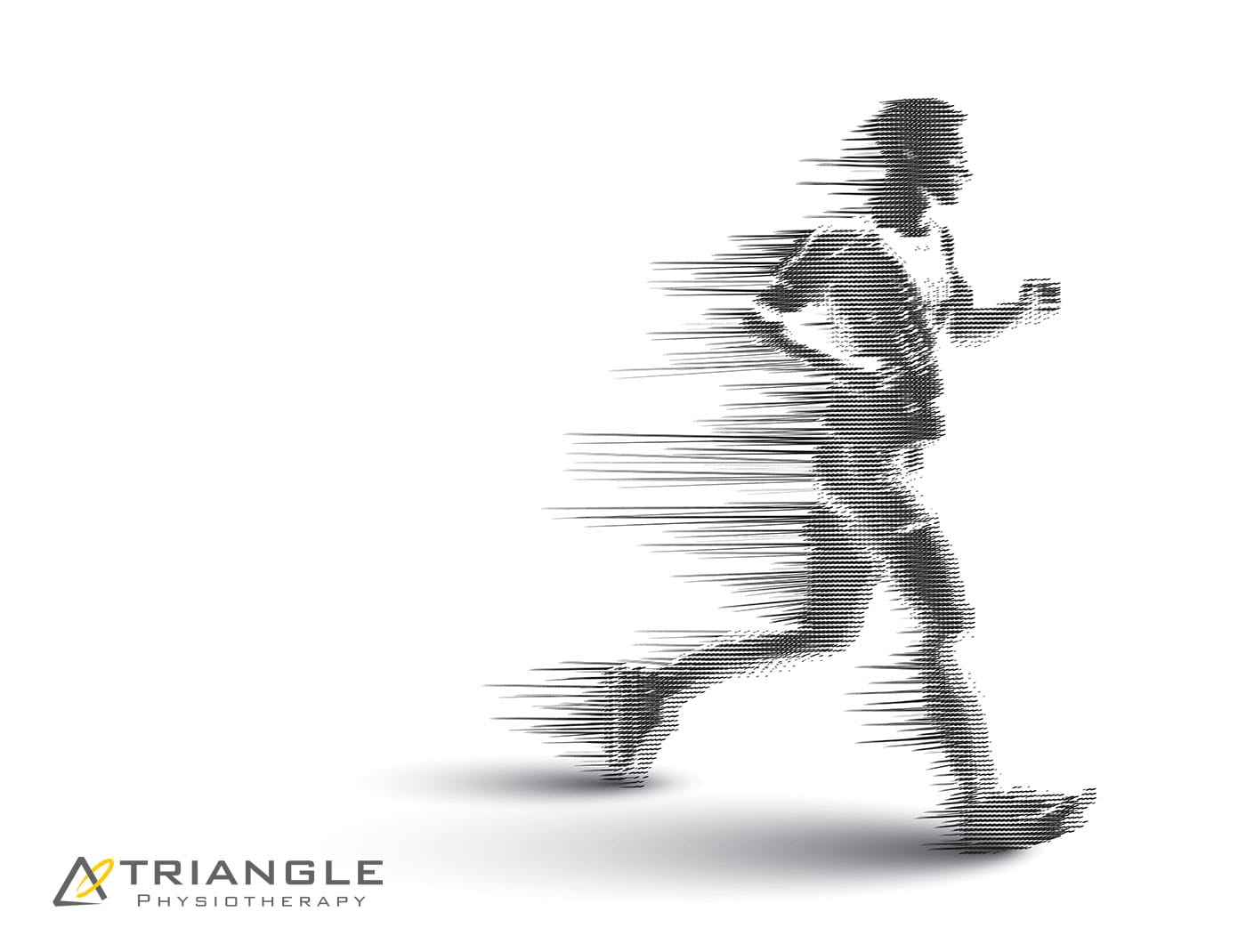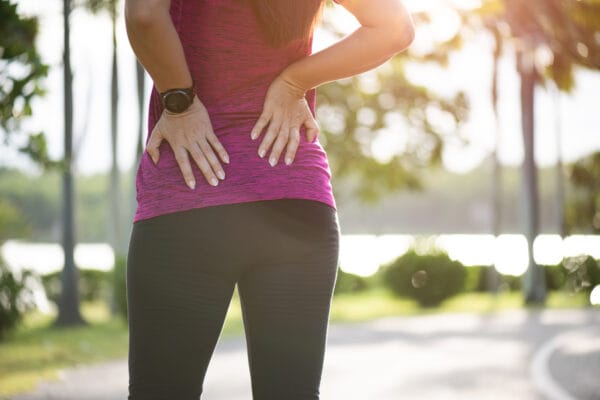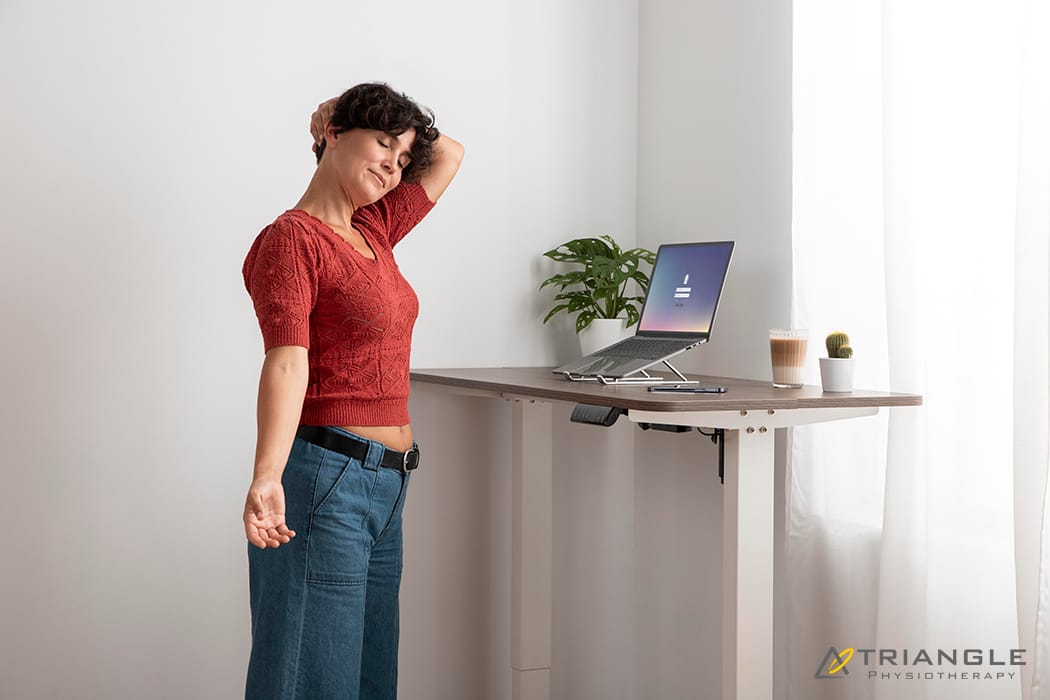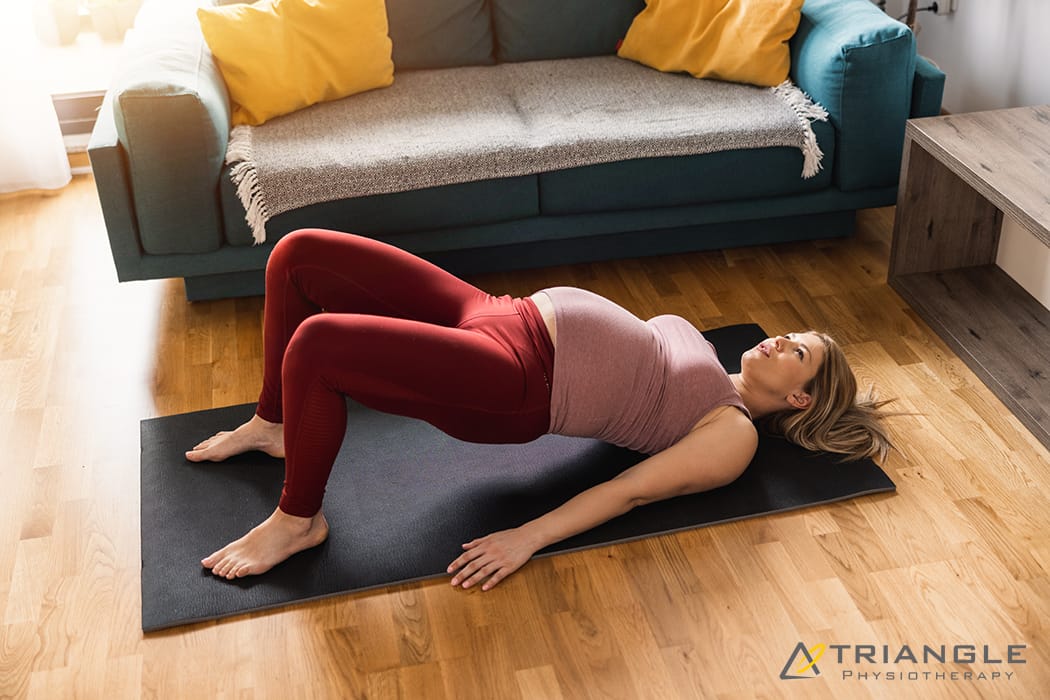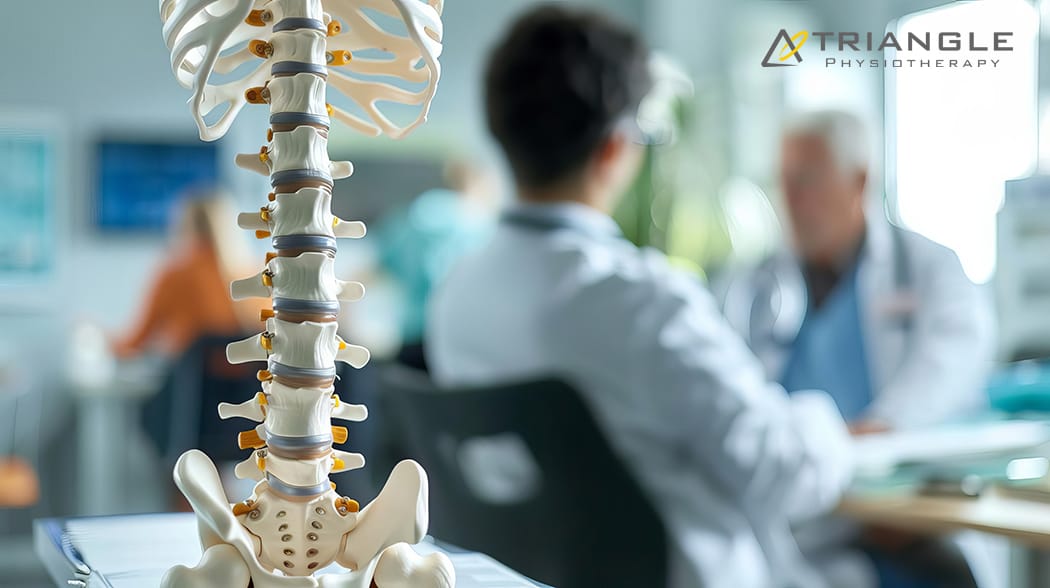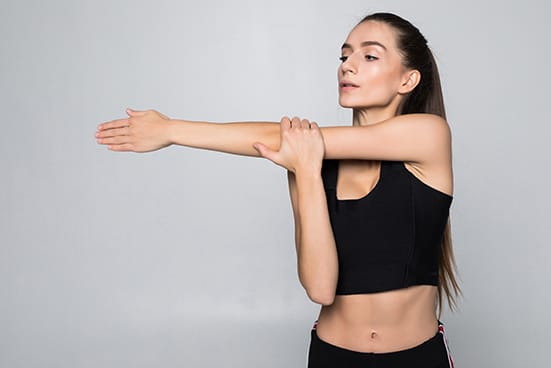Experiencing upper back pain while running can be both frustrating and concerning. While many runners focus on lower body injuries, upper back pain is a common issue that can affect performance and enjoyment. Understanding the causes of this discomfort and exploring effective solutions is essential for maintaining a healthy running routine.
At Triangle Physiotherapy, our team of physiotherapists have the expertise and education to help you develop a plan to ensure your runs are done right!
Understanding Upper Back Pain
Upper back pain during running can arise from various factors, including muscle strain, poor posture, or underlying conditions. The upper back, or thoracic region, comprises the spine and surrounding muscles, which play a crucial role in maintaining proper running form. If any part of this system is compromised, it can lead to discomfort and pain.

Common Causes of Upper Back Pain While Running
- Poor Posture: Runners who hunch their shoulders or lean forward excessively may put strain on their upper back muscles, leading to pain. Maintaining a neutral spine and relaxed shoulders is essential for proper running form.
- Muscle Imbalance: Weakness in the core or upper back muscles can result in poor stabilization during running. This imbalance may lead to overcompensation by other muscles, causing pain.
- Overuse: Increasing running distance or intensity too quickly can lead to muscle fatigue and strain in the upper back. It’s crucial to allow adequate recovery time between runs.
- Tension and Stress: Mental stress can lead to physical tension in the upper body, exacerbating discomfort during exercise. Runners may unconsciously tighten their shoulders and upper back while running, contributing to pain.
How can Physiotherapy help?
Physiotherapy can play a significant role in addressing upper back pain related to running. A physiotherapist will conduct a thorough assessment to identify the underlying causes of your discomfort. Based on this evaluation, they will develop a personalized treatment plan that may include:
- Postural Assessment: Evaluating your running posture and identifying areas for improvement can help alleviate strain on the upper back.
- Strengthening Exercises: Targeted exercises to strengthen the upper back and core muscles can improve stability and support proper running form.
- Stretching and Flexibility Training: Incorporating stretches for the upper back and shoulders can relieve tension and enhance flexibility.
- IMS: Intra muscular Stimulation is an effective tool to trace and treat the root cause, reducing recurrence.
- Education: Learning about proper running techniques and body mechanics can help prevent further injuries.
Tips for Reducing Upper Back Pain While Running
- Warm-Up Properly: Engage in a dynamic warm-up to prepare your muscles for running. Focus on movements that activate the upper back and shoulders.
- Focus on Form: Pay attention to your running posture. Keep your shoulders relaxed and your chest open, and avoid hunching over while you run.
- Strength Train: Incorporate strength training exercises targeting the upper back and core into your fitness routine to build muscle balance and support.
- Gradually Increase Intensity: Avoid sudden increases in running distance or intensity. Follow a structured training plan to prevent overuse injuries.
- Manage Stress: Practice stress-reduction techniques, such as mindfulness or yoga, to help relieve physical tension in the upper body.
FAQs
Why does my upper back hurt when I run?
Upper back pain while running can result from poor posture, muscle imbalances, overuse, or tension. Identifying the specific cause is essential for effective treatment.
What should I expect during my first visit to Triangle Physiotherapy?
During your initial visit, a physiotherapist will assess your posture, movement patterns, and any contributing factors to your pain. They will develop a personalized treatment plan to address your needs.
How many sessions will I need?
The number of sessions varies based on the severity of your pain and your response to treatment. Your physiotherapist will provide an estimate after your assessment.
Do I need a referral to see a physiotherapist?
No, you do not need a referral to access physiotherapy services. You can book an appointment directly, unless needed by insurance for billing purposes.
How soon can I expect to feel better?
Many individuals notice improvements within a few sessions, but the timeline can vary depending on individual circumstances and the nature of the pain.
How can I prevent upper back pain while running?
Focus on maintaining good posture, strengthening your upper back and core, warming up properly, and gradually increasing your running intensity to help prevent pain.
Call us today to get help with any running related back pain issues!
Upper back pain during running is a common issue that can hinder performance and enjoyment. By understanding the underlying causes and implementing effective strategies, you can alleviate discomfort and enhance your running experience. Book an appointment with us to get help!
Back pain is a common complaint that affects millions of people worldwide. It can range from a dull ache to sharp, debilitating pain. Understanding the causes, prevention strategies, and effective treatments is essential for managing this condition.
Understanding Back Pain
Back pain can arise from various sources, including poor posture, muscle strains, or injuries. Other factors such as age, obesity, and sedentary lifestyles can also contribute. Often, back pain stems from the muscles, ligaments, or discs in the spine becoming strained or injured. In some cases, underlying conditions like arthritis or herniated discs can cause chronic pain.
The good news is that the physiotherapists at Triangle Physiotherapy can help you manage back pain and prevent recurrence.
Importance of Physiotherapy when you have Back Pain
Physiotherapy plays a crucial role in both treating and preventing back pain. A physiotherapist can assess your condition, provide tailored exercises, and educate you on proper movement techniques. They can also help manage pain through modalities like heat therapy, ultrasound, or electrical stimulation. Early intervention can prevent the escalation of back issues and promote a quicker recovery.
What can I do if I have Back Pain?
The best thing you can do for any type of pain is to stay active. Whether it is walking, running or yoga, find an activity that keeps you moving.
Neuromuscular Exercises for Pain
Neuromuscular exercises focus on improving the communication between your brain and muscles, enhancing coordination and strength. These exercises can be particularly effective for back pain by stabilizing the spine and improving posture. Common neuromuscular exercises include:
- Bird-Dog: This exercise enhances core stability while promoting balance.

- Plank: Planks engage the entire core, supporting your back muscles.

- Bridge: This helps strengthen the glutes and lower back, essential for overall stability.

Progressive Resistance Training
Incorporating progressive resistance training into your routine can significantly reduce back pain. This type of training involves gradually increasing the weights you lift, which helps build muscle strength and endurance. Stronger muscles support your spine better, reducing the likelihood of injury. Focus on exercises that target your back, core, and lower body, such as deadlifts and rows, while ensuring you maintain proper form.
Incorporating Mobility into Your Daily Routine
Mobility exercises enhance flexibility and range of motion, which can alleviate back pain. Simple stretches like hamstring stretches, spinal twists, and hip flexor stretches can make a significant difference. Incorporate these into your daily routine—perhaps after waking up or during breaks at work. Mobility should be part of your lifestyle, not just an exercise program.
Tips for Safely Performing Exercises
Safety is paramount when exercising, especially if you’re managing back pain. Here are some tips to keep in mind:
- Warm-Up: Always start with a warm-up to prepare your muscles.
- Listen to Your Body: If an exercise causes pain, stop immediately.
- Use Proper Form: Focus on technique over weight to prevent injuries.
- Consult Professionals: Work with a trainer or physiotherapist, especially if you’re new to exercise or recovering from an injury.
Prevention
Preventing back pain is often more effective than treating it after it occurs. Here are some key strategies to help you avoid back issues:
- Maintain Good Posture: Be mindful of how you sit, stand, and lift objects. Keeping your back straight and your shoulders back can significantly reduce strain on your spine.
- Stay Active: Regular physical activity strengthens your back and core muscles, providing better support for your spine.
- Ergonomic Workspace: If you work at a desk, ensure your workstation is set up to promote good posture. Use chairs that offer proper lumbar support and position your computer screen at eye level.
Back pain can be a challenging and frustrating condition, but understanding its causes and implementing preventive measures can lead to relief. Always prioritize safety and seek professional guidance when needed. With the right approach, you can manage and reduce back pain, leading to a healthier, more active lifestyle.
Read also: Rehabilitation for Low Back Pain – Source: Physio Pedia
Sciatica is a term that’s often thrown around, but it’s not a condition itself; it’s a symptom of something else. When people talk about sciatica, they’re referring to pain that radiates along the path of the sciatic nerve, which runs from the lower back through the hips and buttocks and down each leg. This pain can vary from a mild ache to a sharp, burning sensation. It can be debilitating, affecting your daily life and limiting your mobility. With so many treatment options available, one common question is whether chiropractic care can effectively help with sciatica. Let’s dive into this topic and see what the evidence and experience suggest.
Understanding Sciatica
Sciatica typically arises from an issue in the lower back, such as a herniated disc, spinal stenosis, or a misalignment of the vertebrae. These conditions can put pressure on the sciatic nerve, leading to pain, numbness, or tingling sensations that radiate down the leg. The discomfort often worsens with prolonged sitting, standing, or sudden movements, and can be accompanied by muscle weakness or difficulty moving the leg.
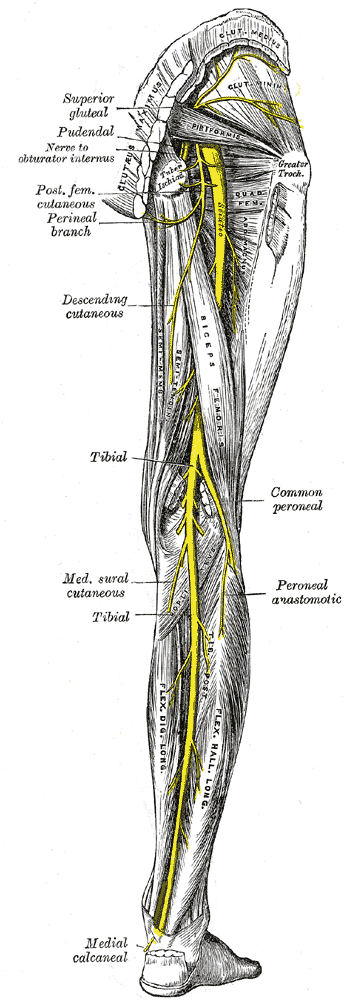
The Role of Chiropractic Care
Chiropractic care focuses on diagnosing and treating musculoskeletal disorders, with an emphasis on spinal health. Chiropractors use manual adjustments and other techniques to correct misalignment in the spine and improve overall function. But can these methods help with sciatica?
1. Spinal Adjustments
One of the primary treatments a chiropractor might offer is spinal adjustments. The goal here is to realign the vertebrae in the spine to reduce pressure on the sciatic nerve. Misalignment or subluxation in the spine can sometimes contribute to sciatica by irritating or compressing the nerve. By performing adjustments, chiropractors aim to restore proper alignment, alleviate nerve pressure, and reduce inflammation, which can, in turn, decrease sciatica symptoms.
2. Flexion-Distraction Therapy
Another technique used by chiropractors is flexion-distraction therapy. This method involves a specialized table that gently stretches and flexes the spine, aiming to relieve pressure on the discs and nerves. It’s often used for conditions like herniated discs, which are a common cause of sciatica. This therapy can help in reducing pain and improving mobility by creating more space within the spinal column and reducing nerve compression.
PS : Our FCAMPT certified physiotherapists (Ashish, Jigisha and Ankit) also practice this technique!
3. Physical Therapy and Exercises
Chiropractors often incorporate physical therapy and specific exercises into their treatment plans for sciatica. These exercises can help strengthen the muscles around the spine, improve flexibility, and promote better posture. For sciatica sufferers, strengthening the core and lower back muscles can provide better support for the spine and reduce the likelihood of future episodes.
4. Lifestyle and Ergonomics Advice
In addition to hands-on treatments, chiropractors also provide guidance on lifestyle changes and ergonomics. They may offer advice on how to sit properly, how to lift objects correctly, and how to maintain good posture throughout the day. These adjustments can help prevent the recurrence of sciatica by addressing the factors that may contribute to the condition.
What the Research Says
Scientific studies on chiropractic care for sciatica have shown promising results. Research indicates that spinal manipulation can be effective in reducing pain and improving function in patients with sciatica. For instance, a study published in The Journal of the American Board of Family Medicine found that chiropractic care, combined with standard medical treatments, provided significant relief for sciatica patients.
However, it’s essential to approach chiropractic care with realistic expectations. While many people find relief from chiropractic adjustments, it may not be a cure-all. The effectiveness of chiropractic treatment can vary based on the underlying cause of sciatica, the severity of the symptoms, and individual patient factors.
Consultation and Care
If you’re considering chiropractic care for sciatica, it’s crucial to consult with a healthcare provider first to determine the underlying cause of your symptoms. A comprehensive evaluation can help in designing a treatment plan tailored to your needs. Chiropractors often work in conjunction with other healthcare professionals to provide a holistic approach to managing sciatica.
In summary, chiropractic care can be a beneficial component in managing sciatica, particularly when it comes to spinal adjustments, flexion-distraction therapy, and strengthening exercises. While not a guaranteed solution for everyone, many people find that chiropractic treatments help reduce pain and improve their quality of life. As with any medical treatment, it’s important to approach chiropractic care with informed expectations and in collaboration with your overall healthcare team. If you’re struggling with sciatica, a consultation with a chiropractor might be a worthwhile step in your journey toward relief and recovery.
Is there a Chiropractor in Oakville that can help with Sciatica?
The Chiropractors at Triangle Physiotherapy in Oakville are qualified and experienced professionals that can help you with your Sciatica.
Working from home has become the norm for many people, but with it comes a set of unique challenges— chief among them is the risk of developing musculoskeletal issues. Hours spent hunched over a laptop or sitting at a desk can lead to discomfort and pain, especially in the back, neck, and shoulders. To counteract these issues, incorporating simple stretches into your daily routine can be highly effective. This blog will explore how stretching and other physiotherapy principles can prevent and treat injuries, manage pain, and promote overall well-being.

Understanding the Injury
Before diving into the specifics of stretching, it’s crucial to understand why these injuries occur. Prolonged sitting and poor posture are common causes of discomfort for those working from home. These issues can lead to muscle strain, poor spinal alignment, and reduced flexibility. Typical symptoms include:
- Back Pain: Often due to poor posture or prolonged sitting.
- Neck Pain: Caused by leaning forward or poor desk ergonomics.
- Shoulder Pain: Often related to repetitive strain or poor posture.

Prevention and Treatment
Preventing injury is always better than treating it. Regular stretching and proper ergonomics can help keep your body in balance and reduce the risk of pain. However, if you do experience discomfort, addressing it early can prevent it from becoming a chronic issue.
Importance of Physiotherapy for Injury
Physiotherapy is vital for both preventing and treating musculoskeletal injuries. A physiotherapist can provide tailored exercises and stretches that target specific issues, helping to alleviate pain, improve posture, and enhance overall function. They use a combination of techniques, including manual therapy, exercise, and education, to treat and prevent injuries.
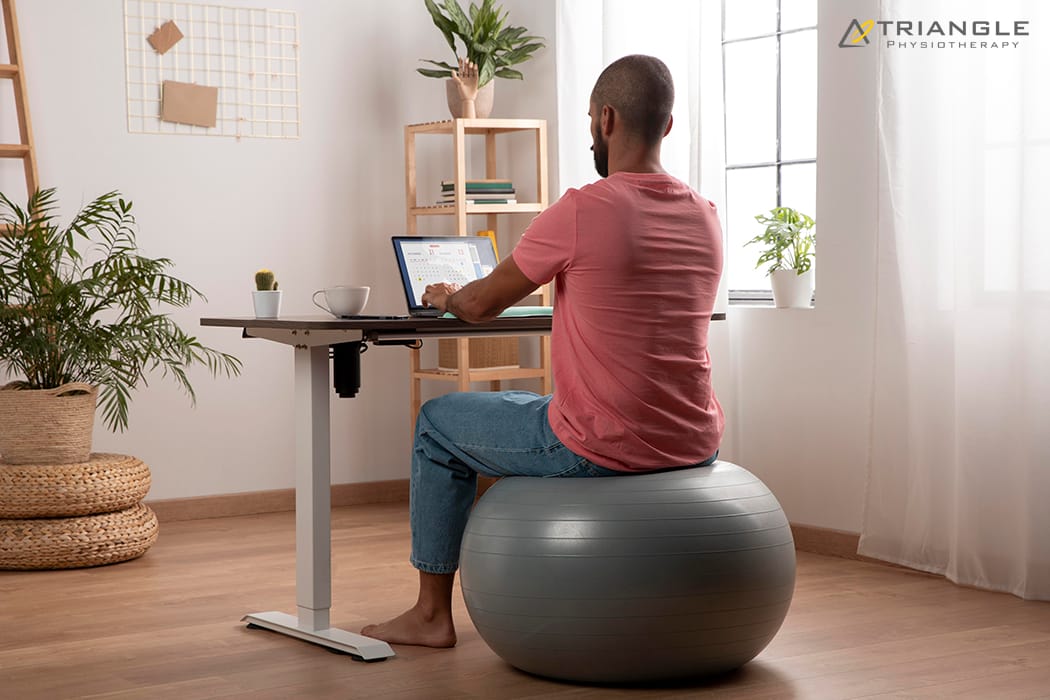
Key Principles of Physiotherapy Exercises for Pain Relief
- Personalization: Exercises should be tailored to your specific needs and injury.
- Gradual Progression: Start with basic exercises and gradually increase intensity.
- Consistency: Regular practice is essential for long-term relief and prevention.
- Proper Form: Ensuring correct technique is crucial to avoid further injury.
Strengthening Exercises
Strengthening the muscles around your back, neck, and shoulders can help support your spine and prevent pain. Here are a few key exercises to incorporate:
- Seated Rows: Using a resistance band or a machine, this exercise strengthens your upper back and shoulders. Sit with your back straight, pull the band or handle towards you, and squeeze your shoulder blades together.
- Wall Angels: Stand with your back against a wall and your arms raised to form a “W” shape. Slowly slide your arms up the wall to form a “Y,” then return to the starting position. This exercise helps improve shoulder mobility and posture.
- Bridges: Lie on your back with your knees bent and feet flat on the floor. Lift your hips towards the ceiling while squeezing your glutes and lower back muscles. This exercise strengthens your lower back and glutes, which can support your spine.
Neuromuscular Exercises for Pain Management and Prevention
Neuromuscular exercises focus on improving the connection between your brain and muscles, which can help with pain management and injury prevention:
- Core Stabilization: Planks and side planks strengthen your core, improving your body’s ability to support your spine. Hold each position for 20-30 seconds and gradually increase as you build strength.
- Pelvic Tilts: Lying on your back with your knees bent, flatten your lower back against the floor by tightening your abdominal muscles. This exercise helps improve lower back stability.
- Neck Retractions: Sit or stand with your back straight and gently pull your head back, tucking your chin towards your chest. This exercise can help relieve neck tension and improve posture.
Progressive Resistance Training
Progressive resistance training involves gradually increasing the weight or resistance you use during exercise. This type of training can enhance muscle strength and endurance, which is beneficial for injury prevention:
- Dumbbell Rows: Hold a dumbbell in one hand, place your other hand and knee on a bench for support, and pull the dumbbell towards your hip. This exercise targets your upper back and biceps.
- Shoulder Presses: Using dumbbells or a barbell, press the weights overhead while keeping your core engaged. This strengthens your shoulders and upper back.
- Single Leg Squat: To perform a single-leg squat, stand on one leg with your other leg extended slightly forward. Lower your body by bending your standing knee and pushing your hips back, keeping your torso upright. Lower as far as comfortable, then return to the starting position. Repeat on the other leg.
Incorporating Stretching and Flexibility Exercises in Your Routine
Incorporating stretching and flexibility exercises into your daily routine can greatly benefit your overall comfort and well-being:
- Neck Stretch: Gently tilt your head towards one shoulder, using your hand to apply light pressure. Hold for 20-30 seconds, then switch sides.
- Shoulder Stretch: Bring one arm across your chest and use the opposite arm to press it closer to your body. Hold for 20-30 seconds and switch arms.
- Back Stretch: Sit in a chair, cross one leg over the other, and twist your torso towards the top leg. Hold for 20-30 seconds and switch sides.
- Hip Flexor Stretch: Kneel on one knee with the other foot in front. Gently push your hips forward to stretch the front of your hip. Hold for 20-30 seconds and switch legs.
Working from home doesn’t have to come with a side of back and neck pain. By incorporating simple stretches and following key physiotherapy principles, you can prevent injuries, manage pain, and maintain overall comfort. Remember to personalize your exercises, progress gradually, and stay consistent. If you experience persistent discomfort, don’t hesitate to consult a physiotherapist to tailor a program to your specific needs. With the right approach, you can create a healthier, more comfortable home workspace.
Need advice on how to work from home without aches and pains? We can help!
Sitting for prolonged periods can cause many issues and create long term health problems.
Our team of expert physiotherapists in Mississauga are here to assist you in managing injuries or conditions that have reduced your ability to work comfortably from home without having pain and posture-related injuries.
Book an appointment with one of our physiotherapists in Mississauga today!
Pregnancy is a remarkable journey filled with joy and anticipation. However, it also brings various physical challenges, one of the most common being back pain. This blog explores the causes of pregnancy back pain and how physiotherapy can provide relief. We’ll delve into the benefits of pelvic health physiotherapy in Mississauga and the holistic approach it offers to expecting mothers.

Causes of Pregnancy Back Pain
Hormonal Changes
During pregnancy, the body produces a hormone called relaxin, which helps to loosen the ligaments in the pelvic area to prepare for childbirth. While necessary, this increased flexibility can lead to instability and back pain.
Weight Gain
The additional weight gained during pregnancy puts extra strain on the spine. This added pressure can cause discomfort and pain, particularly in the lower back.
Postural Changes
As the baby grows, the center of gravity shifts forward, leading to changes in posture. This can result in muscle strain and back pain as the body adjusts to the new alignment.
Stress
Emotional stress can cause muscle tension in the back, leading to pain. It’s essential to manage stress effectively during pregnancy to minimize its impact on physical health.
How Physiotherapy Can Help with Pregnancy Back Pain
Personalized Treatment Plans
Physiotherapy in Mississauga offers personalized treatment plans tailored to the specific needs of pregnant women. These plans focus on alleviating back pain through targeted exercises and techniques.
Pain Relief Techniques
Physiotherapists use a variety of techniques to relieve pregnancy back pain, including manual therapy, massage, and specific exercises designed to strengthen the back and core muscles.
Pelvic Health Physio in Mississauga
Pelvic health physiotherapy is a specialized branch of physiotherapy that focuses on the pelvic floor muscles, which play a crucial role during pregnancy and childbirth. Pelvic health physiotherapists in Mississauga helps in:
- Strengthening Pelvic Floor Muscles: Exercises to enhance the strength and function of these muscles.
- Improving Posture: Guidance on maintaining proper posture to reduce back strain.
- Breathing Techniques: Techniques to manage pain and improve overall comfort during pregnancy.
Benefits of Physiotherapy for Pregnancy Back Pain
Reducing Pain and Discomfort
Regular physiotherapy sessions can significantly reduce back pain and discomfort, improving the quality of life for expecting mothers.
Enhancing Mobility
Physiotherapy helps maintain and improve mobility, making daily activities easier and more comfortable.
Preparing for Childbirth
Pelvic physio in Mississauga not only alleviates back pain but also prepares the body for childbirth by strengthening the pelvic floor muscles and improving overall physical readiness.
Postpartum Recovery
Physiotherapy continues to be beneficial postpartum, aiding in the recovery process and helping new mothers regain their strength and mobility.
What do I do next?
Find the Right Physiotherapist in Mississauga
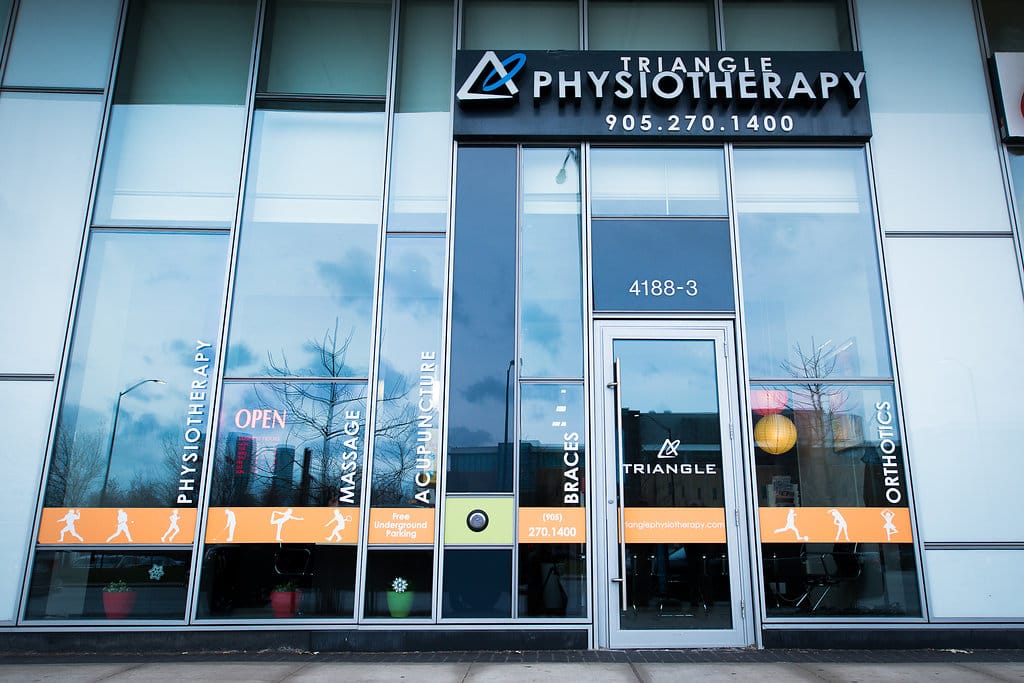
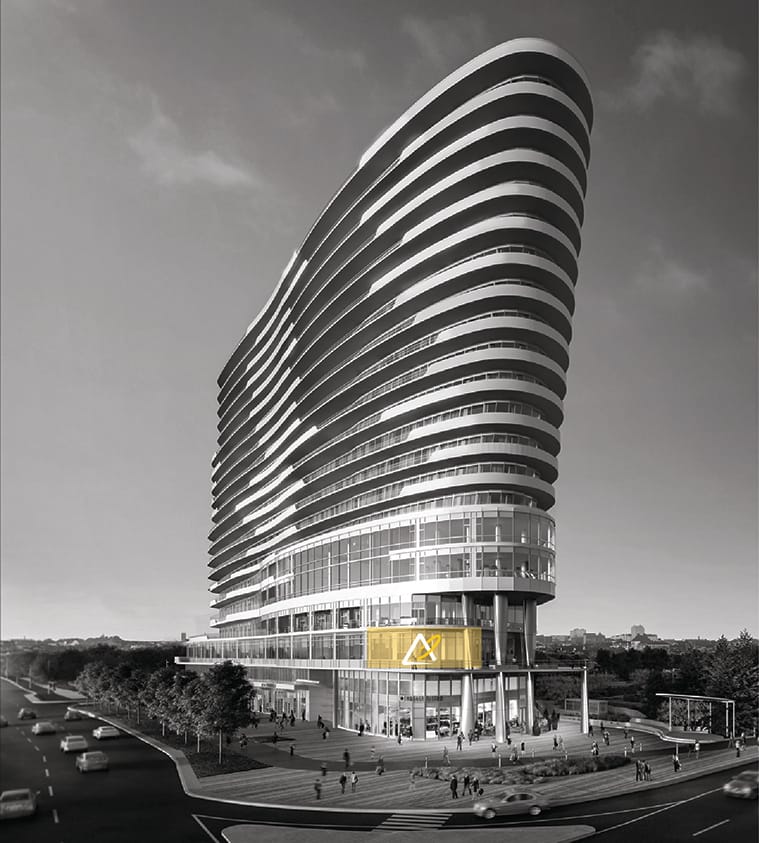
When looking for physiotherapy in Mississauga, it’s essential to find a qualified and experienced physiotherapist who specializes in pregnancy and pelvic health. Our Locations in Mississauga have trained and experienced pelvic health physiotherapists with advanced training in pelvic health including Labour and Delivery Prep.
Pregnancy back pain is a common but manageable condition. With the right approach, such as physiotherapy in Mississauga, expecting mothers can find relief and improve their overall well-being. Pelvic health physiotherapists at Triangle Physiotherapy in Mississauga offers specialized care that addresses the unique challenges of pregnancy, providing a holistic approach to pain management and preparation for childbirth. By incorporating physiotherapy into their prenatal care routine, pregnant women can enjoy a more comfortable and healthy pregnancy journey.
Triangle Physiotherapy has 2 locations in Mississauga to help you with your pregnancy-related back pain:
Triangle Physiotherapy Square One
Triangle Physiotherapy Erin Mills
“At Triangle Physiotherapy, we have multiple locations across the GTA, including Physiotherapy in Etobicoke, Oakville, North York, Toronto, Lawrence Park, Queens Quay, Erin Mills, Mississauga, and Liberty Village. Our clinics are dedicated to providing specialized care for pregnancy-related back pain, ensuring that every expecting mother receives the best possible treatment.”
Back pain is a common complaint affecting people of all ages and lifestyles. It can range from a mild, nagging ache to severe pain that hinders daily activities. Understanding the causes and treatments for back pain is crucial for maintaining a healthy and active lifestyle. One of the most effective treatments for back pain is physiotherapy, which offers a holistic approach to pain management and recovery.
Causes of Back Pain
- Poor Posture: Sitting or standing improperly for prolonged periods can strain the back muscles and spine.
- Injury: Accidents, falls, or sports injuries can cause acute back pain.
- Muscle Strain: Overuse or sudden movements can lead to muscle or ligament strains.
- Herniated Disc: This occurs when the soft tissue inside a disc pushes out, irritating nearby nerves.
- Arthritis: Conditions like osteoarthritis can cause the space around the spinal cord to narrow, leading to back pain.
- Medical Conditions: Diseases such as scoliosis, osteoporosis, or kidney problems can also result in back pain.
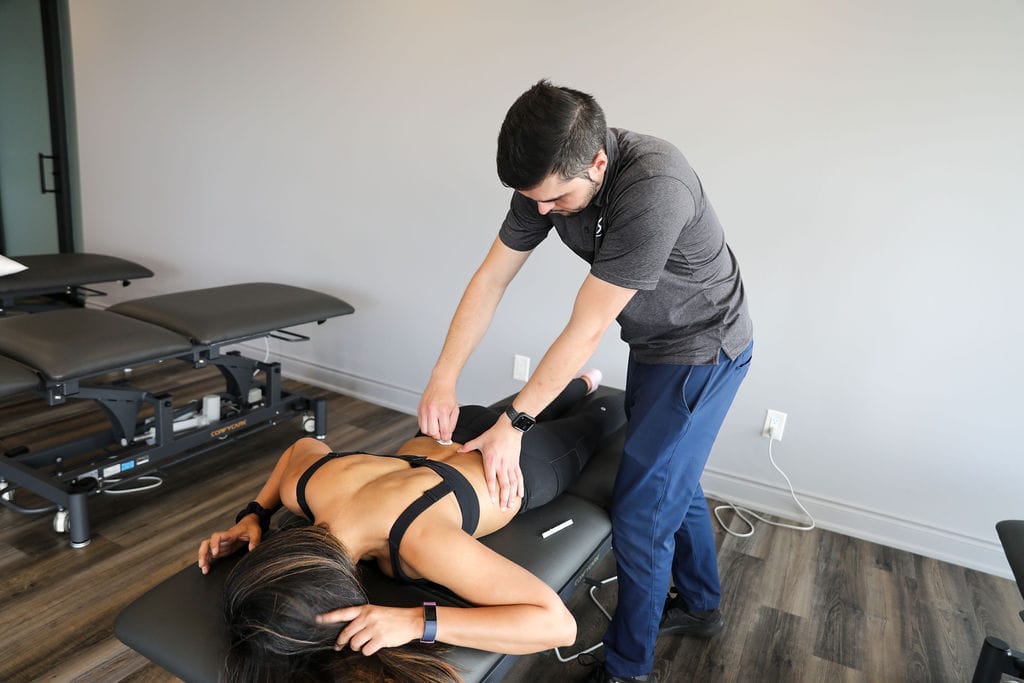
Back pain can be attributed to various factors, including:
How Physiotherapy Helps
Physiotherapy is a non-invasive treatment that addresses the root causes of back pain through a variety of techniques. Here’s how physiotherapy can be beneficial:
- Pain Relief: Physiotherapists use manual therapy techniques, such as massage and mobilization, to alleviate pain and reduce muscle tension.
- Improving Mobility: Through targeted exercises, physiotherapy helps improve the range of motion and flexibility of the spine and surrounding muscles.
- Strengthening Muscles: A customized exercise regimen strengthens the core muscles that support the spine, reducing the risk of future injuries.
- Posture Correction: Physiotherapists assess and correct posture, teaching patients how to maintain proper alignment to prevent strain.
- Education and Advice: Patients learn about body mechanics and ergonomics, empowering them to make lifestyle changes that support back health.
- Prevention: Regular physiotherapy sessions can help identify potential issues early, preventing the progression of back pain.
Common Physiotherapy Techniques for Back Pain
- Manual Therapy: Includes hands-on techniques to manipulate joints and soft tissues, improving mobility and reducing pain.
- Exercise Therapy: Tailored exercises aimed at strengthening, stretching, and stabilizing the back muscles.
- Electrotherapy: Uses electrical currents to reduce pain and inflammation.
- Heat and Cold Therapy: Applying heat or cold packs to alleviate pain and reduce swelling.
- Education and Advice: Providing patients with knowledge on posture, ergonomics, and activity modification to prevent back pain recurrence.
The Road to Recovery
The journey to recovery with physiotherapy involves several steps:
- Assessment: A thorough evaluation of the patient’s medical history, pain intensity, and physical condition.
- Treatment Plan: Development of a personalized treatment plan based on the assessment.
- Regular Sessions: Consistent physiotherapy sessions to implement the treatment plan and monitor progress.
- Home Exercises: Patients are given exercises to perform at home to complement in-clinic treatments.
- Follow-Up: Regular follow-ups to adjust the treatment plan as needed and ensure long-term success.
Conclusion
Back pain can significantly impact the quality of life, but physiotherapy offers a comprehensive and effective solution. By addressing the underlying causes and promoting healthy practices, physiotherapy helps individuals recover from back pain and prevent its recurrence. If you’re struggling with back pain, consider consulting a physiotherapist to embark on a path toward relief and improved well-being.
Click here to book an appointment for back pain treatment with a physiotherapist at one of our eight locations.
- Physiotherapy Etobicoke – Triangle Physiotherapy Etobicoke
- Oakville Physiotherapy Clinic – Triangle Physiotherapy Oakville
- Physiotherapy North York – Triangle Physiotherapy North York
- Mississauga Physiotherapy Clinics – Triangle Physiotherapy Mississauga
- Downtown Physiotherapy Clinics – Triangle Physiotherapy King West
- Uptown Physiotherapy Clinics – Triangle Physiotherapy Lawrence Park
- Physiotherapy Clinic Downtown Toronto – Triangle Physiotherapy Queens Quay
- Physiotherapy Clinics Mississauga – Triangle Physiotherapy Erin Mills
“Back pain can significantly impact your quality of life, but with the right physiotherapy care, you can find relief and restore function. Triangle Physiotherapy is available across the GTA, offering expert services at Physiotherapy in Etobicoke, Oakville, North York, Toronto, Lawrence Park, Queens Quay, Erin Mills, Mississauga, and Liberty Village. Our skilled team is dedicated to helping you manage and overcome back pain effectively.”
Spinal fusion surgery is a medical procedure used to permanently join two or more vertebrae in the spine, eliminating motion between them. The goal of the surgery is to reduce pain, correct deformities, or improve stability in the spine.
When would I need Spinal Fusion Surgery?
Spinal fusion surgery is typically recommended for various spine conditions, including:
- Degenerative disc disease: When the discs between vertebrae break down, causing pain.
- Spondylolisthesis: When one vertebra slips forward over the one below it.
- Spinal stenosis: Narrowing of the spinal canal, leading to nerve compression.
- Scoliosis: Abnormal curvature of the spine.
- Fractures: Vertebrae that are broken or dislocated.
- Tumors: Removal of tumors that affect spinal stability.
- Infections: Infections that have caused damage to the vertebrae.
When do I start physiotherapy after surgery?
The timing of when to start physiotherapy after spinal fusion surgery depends on several factors, including the specifics of the surgery, the patient’s overall health, and the surgeon’s recommendations.
What does post-surgery rehab involve?
Immediate Postoperative Period (0-6 Weeks)
- Initial Phase: Physiotherapy may start in the hospital within a day or two after surgery. The focus is on gentle movements and exercises to improve circulation and prevent complications.
- Activities:
- Breathing exercises to prevent lung complications.
- Gentle leg movements like ankle pumps to improve blood flow.
- Log rolling technique for safe movement in and out of bed.
- Short, frequent walks to promote circulation and reduce stiffness.
Early Rehabilitation Phase (6-12 Weeks)
- When: Typically, more structured physical therapy begins around 4 to 6 weeks after surgery, depending on the surgeon’s assessment.
- Goals: Gradually increase mobility, start gentle strengthening exercises, and improve functional movements.
- Activities:
- Range of motion exercises.
- Gentle strengthening exercises for the core and lower extremities.
- Walking programs to gradually increase distance and duration.
- Education on proper body mechanics and posture.
Late Rehabilitation Phase (3-6 Months)
- When: Around 3 months post-surgery, assuming there are no complications.
- Goals: Restore full function, enhance strength and endurance, and improve posture and body mechanics.
- Activities:
- More advanced strengthening exercises using resistance bands or light weights.
- Low-impact aerobic exercises like swimming or cycling.
- Balance and coordination exercises.
- Functional training for daily activities.
Long-Term Rehabilitation Phase (6-12 Months)
- When: After 6 months, the patient should continue with physiotherapy based on individual progress and goals.
- Goals: Achieve optimal strength, flexibility, and functional ability, and prevent recurrence of symptoms.
- Activities:
- Progressive resistance training.
- Gradual reintroduction of higher-impact activities, if appropriate.
- Sport-specific training for athletes.
- Ongoing education on maintaining spine health.
Key Points to Consider
- Surgeon’s Recommendations: Always follow the specific guidelines and timelines provided by the surgeon, as they know the details of the surgery and individual patient needs.
- Listen to Your Body: Avoid pushing through pain. Pain is a signal that something might be wrong, and it’s important to communicate any discomfort to the physiotherapist or surgeon.
- Individual Variation: Each patient’s recovery is unique. Factors such as age, overall health, and the complexity of the surgery will influence the timing and intensity of physiotherapy.
Starting physiotherapy at the right time is crucial for a successful recovery, and adhering to a structured rehabilitation program can significantly enhance outcomes after spinal fusion surgery.
Click here to book an appointment for post-surgery rehab with a physiotherapist at one of our eight locations.
- Physiotherapy Etobicoke – Triangle Physiotherapy Etobicoke
- Oakville Physiotherapy Clinic – Triangle Physiotherapy Oakville
- Physiotherapy North York – Triangle Physiotherapy North York
- Mississauga Physiotherapy Clinics – Triangle Physiotherapy Mississauga
- Downtown Physiotherapy Clinics – Triangle Physiotherapy King West
- Uptown Physiotherapy Clinics – Triangle Physiotherapy Lawrence Park
- Physiotherapy Clinic Downtown Toronto – Triangle Physiotherapy Queens Quay
- Physiotherapy Clinics Mississauga – Triangle Physiotherapy Erin Mills
General Information: The information provided on this blog is for general informational purposes only. While we strive to ensure the accuracy and relevance of our content, we make no guarantees about the completeness, reliability, or accuracy of the information.
Not Professional Advice: The content on this blog does not constitute professional advice. It is not a substitute for professional medical, legal, financial, or other professional advice. Always seek the guidance of a qualified professional with any questions you may have regarding your specific situation.
Recovering from spinal fusion surgery requires careful physiotherapy to restore mobility and strength. Whether you need physiotherapy in Etobicoke, Oakville, North York, Toronto, Lawrence Park, Queens Quay, Erin Mills, Mississauga, or Liberty Village, there are expert physiotherapists available to guide your recovery journey and help you regain your quality of life.
Working and studying from home can take a toll on your body and mind, making it crucial to incorporate some daily movement. Simple actions like walking around your workspace while on a call or standing up while having a snack can help reduce sedentary behavior. Additionally, daily stretching can prevent issues such as “tech neck” and back pain.
How often should you stretch working from home?
When working from home, it’s beneficial to stretch regularly to prevent stiffness and discomfort. Here are some general recommendations:
- Every 30-60 Minutes: Aim to take a short break to stand up, move around, and do some stretches. This helps prevent prolonged periods of inactivity and reduces the risk of musculoskeletal issues.
- Mini Breaks: Take a few minutes every hour to do some simple stretches or walk around. This can help improve circulation and reduce muscle tension.
- Daily Stretching Routine: Incorporate a more comprehensive stretching routine at least once a day, focusing on areas prone to tension such as the neck, shoulders, back, and hips.
By following these guidelines, you can maintain flexibility, reduce the risk of pain, and improve overall well-being while working from home.
What stretches can I do at my desk?
Tricep Stretch
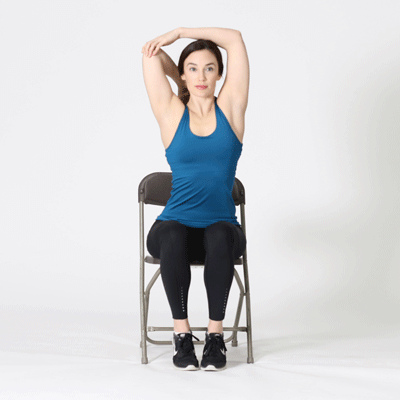
Neck Stretch

Upper Body and Arm Stretch

Trunk Rotation Stretch

Shoulder Shrug Stretch

Stretch Courtesy: https://uwaterloo.ca/campus-wellness/blog/post/desk-stretches
If you are experiencing persistent neck pain, back pain or discomfort, it is advisable to consult a physiotherapist, for proper evaluation and guidance.
Click here to book an appointment with a physiotherapist at one of our eight locations.
- Physiotherapy Etobicoke – Triangle Physiotherapy Etobicoke
- Oakville Physiotherapy Clinic – Triangle Physiotherapy Oakville
- Physiotherapy North York – Triangle Physiotherapy North York
- Mississauga Physiotherapy Clinics – Triangle Physiotherapy Mississauga
- Downtown Physiotherapy Clinics – Triangle Physiotherapy King West
- Uptown Physiotherapy Clinics – Triangle Physiotherapy Lawrence Park
- Physiotherapy Clinic Downtown Toronto – Triangle Physiotherapy Queens Quay
- Physiotherapy Clinics Mississauga – Triangle Physiotherapy Erin Mills
Incorporating simple stretches into your routine can help reduce back pain when working from home. For personalized guidance, you can seek physiotherapy in Etobicoke, Oakville, North York, Toronto, Lawrence Park, Queens Quay, Erin Mills, Mississauga, or Liberty Village, where experienced physiotherapists can create a tailored plan to support your back health and overall well-being.
What is Sciatica?
Sciatica is a term used to describe a condition that affects the sciatic nerve in the leg. The client generally experiences pain and/or tingling, and numbness along the course of the nerve. This condition typically initiates in the lower back and the symptoms travel down the leg. The sciatic nerve originates by union of several nerve roots in the lower back and forms the largest nerve in the body. The sciatic nerve then passes through bony tunnels and various muscles which are compactly arranged and terminates in the knee. If the nerve gets irritated anywhere during this course, it may lead to Sciatica. The other most common cause is a ruptured intervertebral disc which may press on the nerve.
What are the symptoms of Sciatica?
- Pain – begins in the lower back and proceeds along the length of the nerve. It can be mild/sharp/excruciating. It may be constant or at intervals.
- Tingling &/or numbness- also along the length of the nerve.
- Muscle weakness may be present in the leg or the foot.
- Affected by posture
What are the causes of Sciatica?
Some of the most common causes of sciatica are:
- Herniated disc
- Degeneration of lumbar spine
- Spinal stenosis
- Trauma or fracture to the spine
- Irritation of sacroiliac joint
- Piriformis syndrome
- Muscle tightness such as that of the hamstring
What are the 7 best exercises for Sciatica?
Some of the most effective exercises for sciatica are:
- Pelvic Tilts: Lie on your back with knees bent and feet flat on the floor. Tighten your abdominal muscles and tilt your pelvis upward slightly, flattening your back against the floor. Hold for a few seconds, then release. Repeat several times.
- Piriformis Stretch: Sit on a chair with feet flat on the floor. Cross the affected leg over the opposite knee, then gently lean forward while keeping your back straight. Hold the stretch for 15-30 seconds and repeat on the other side.
- Hamstring Stretch: Lie on your back with one leg bent and the other extended straight up. Hold the back of your thigh of the straight leg with both hands and gently pull it towards your chest until you feel a stretch in the hamstring. Hold for 15-30 seconds and switch legs.
- Seated Spinal Twist: Sit on the floor with legs extended in front of you. Bend one knee and place the foot on the outside of the opposite knee. Twist your torso towards the bent knee, placing the opposite elbow on the outside of the bent knee. Hold for 15-30 seconds and switch sides.
- Child’s Pose: Start on your hands and knees, then sit back on your heels while reaching your arms forward on the ground. Hold the stretch, feeling the elongation in your spine and lower back. Hold for 15-30 seconds and repeat as needed.
- Cat-Cow Stretch: Start on your hands and knees in a tabletop position. Inhale, arching your back and lifting your head and tailbone towards the ceiling (Cow Pose). Exhale, rounding your back and tucking your chin to your chest (Cat Pose). Repeat for several breaths.
- Bridging: Lie on your back with knees bent and feet flat on the floor. Engage your core and glutes as you lift your hips towards the ceiling, creating a straight line from shoulders to knees. Hold for a few seconds, then lower back down. Repeat for several repetitions.
How do I book an appointment at a Triangle Physiotherapy Clinic near me?
Click HERE to book an appointment with a physiotherapist at one of our eight locations.
- Physiotherapy Etobicoke – Triangle Physiotherapy Etobicoke
- Oakville Physiotherapy Clinic – Triangle Physiotherapy Oakville
- Physiotherapy North York – Triangle Physiotherapy North York
- Mississauga Physiotherapy Clinics – Triangle Physiotherapy Mississauga
- Downtown Physiotherapy Clinics – Triangle Physiotherapy King West
- Uptown Physiotherapy Clinics – Triangle Physiotherapy Lawrence Park
- Physiotherapy Clinic Downtown Toronto – Triangle Physiotherapy Queens Quay
- Physiotherapy Clinics Mississauga – Triangle Physiotherapy Erin Mills
“Dealing with sciatica can be challenging, but with the right exercises and physiotherapy, relief is within reach. Triangle Physiotherapy offers specialized care across the GTA, including Physiotherapy in Etobicoke, Oakville, North York, Toronto, Lawrence Park, Queens Quay, Erin Mills, Mississauga, and Liberty Village. Our expert team is dedicated to helping you manage and alleviate sciatica pain effectively.”
Gardening is a deeply rewarding hobby, but for many enthusiasts, it can also be a source of physical discomfort and pain. From sore backs to achy knees, the joys of gardening can sometimes be overshadowed by the strain it puts on our bodies. However, with the right techniques and precautions, it’s possible to enjoy gardening without the pain. In this blog post, we’ll explore some helpful tips and tricks to make your gardening experience as enjoyable and pain-free as possible.
Proper Body Mechanics
One of the most important aspects of pain-free gardening is practicing proper body mechanics. This means using correct posture and techniques to minimize strain on your muscles and joints. Here are a few key tips:
- Bend at the knees, not at the waist, when lifting heavy objects such as bags of soil or pots.
- Use ergonomic gardening tools with padded handles to reduce strain on your hands and wrists.
- Take frequent breaks and avoid staying in one position for too long to prevent stiffness and discomfort.
Warm-up
Just like any other physical activity, gardening can benefit from a proper warm-up routine. Before diving into your gardening tasks, take a few minutes to stretch your muscles and loosen up your joints. Simple exercises like arm circles, leg swings, and back stretches can help prepare your body for the work ahead and reduce the risk of injury.
Choose the Right Tools
Investing in the right gardening tools can make a world of difference when it comes to preventing pain and discomfort. Look for tools that are lightweight, ergonomic, and designed to reduce strain on your body. Long-handled tools can help you avoid bending over excessively, while padded kneelers can protect your knees during tasks like planting and weeding.
Break Tasks into Manageable Chunks
Instead of trying to tackle your entire garden in one marathon session, break your gardening tasks into smaller, more manageable chunks. Spread out your work over several days or weeks to give your body time to rest and recover between sessions. Not only will this approach help prevent pain and fatigue, but it will also allow you to enjoy your time in the garden without feeling overwhelmed.
Embrace Container Gardening
If you struggle with mobility issues or have limited space, container gardening can be a fantastic alternative to traditional gardening. By planting in pots and containers, you can bring the joys of gardening right to your doorstep without the need for bending, kneeling, or heavy lifting. Plus, container gardening allows for greater flexibility and creativity in your garden design.

How do I book an appointment with a Physiotherapist near me?
Click HERE to book an appointment with a physiotherapist or chiropractor at one of our eight locations.
- Physiotherapy Etobicoke – Triangle Physiotherapy Etobicoke
- Oakville Physiotherapy Clinic – Triangle Physiotherapy Oakville
- Physiotherapy North York – Triangle Physiotherapy North York
- Mississauga Physiotherapy Clinics – Triangle Physiotherapy Mississauga
- Downtown Physiotherapy Clinics – Triangle Physiotherapy King West
- Uptown Physiotherapy Clinics – Triangle Physiotherapy Lawrence Park
- Physiotherapy Clinic Downtown Toronto – Triangle Physiotherapy Queens Quay
- Physiotherapy Clinics Mississauga – Triangle Physiotherapy Erin Mills
Gardening can be a joyful activity without the burden of pain, especially with the right guidance and exercises. If you’re experiencing discomfort, consider seeking physiotherapy in Etobicoke, Oakville, North York, Toronto, Lawrence Park, Queens Quay, Erin Mills, Mississauga, or Liberty Village. Expert physiotherapists in these areas can help you manage pain and improve your strength, so you can enjoy gardening pain-free.

